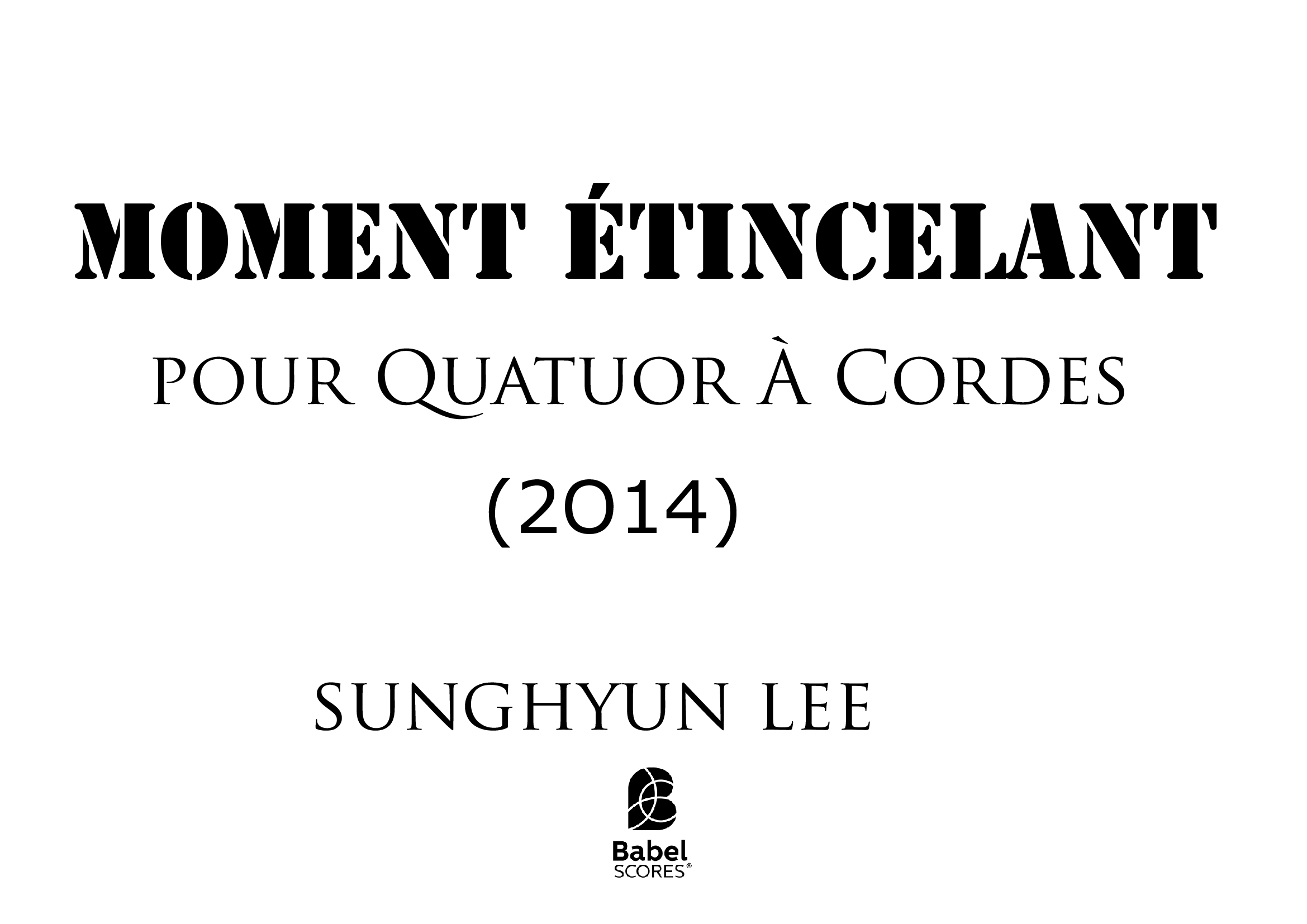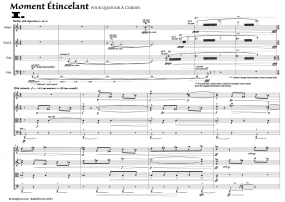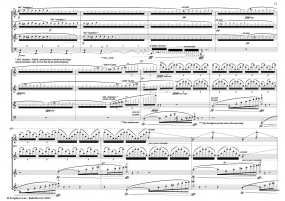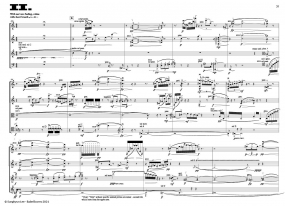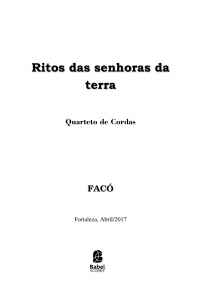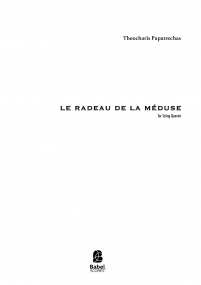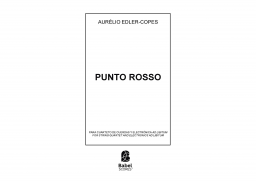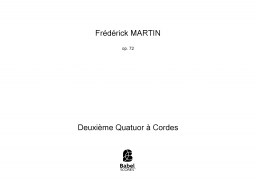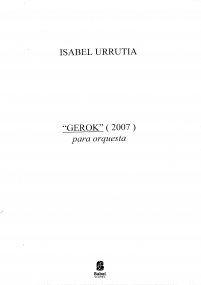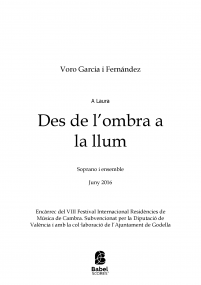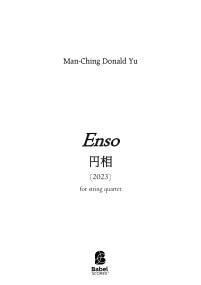Moment Étincelant
Sunghyun Lee - Moment Étincelant pour Quatuor à Cordes (2014)
11,33 €
Versión impresa (+14,80 € impresión y envío). Colissimo7-14 days aprox.
Versión digital (+0,00 €) para descarga
Al comprar una partitura, usted puede contactar al compositor aquí mismo!
Especificaciones
Region
Europe
Estimated Duration
20 - 25min
Date
2014
ISMN : 979-0-2325-5543-0
Videos alrededor de ésta pieza
Descripción
I composed String Quartet “Moment Etincelant” in 2014. This work is very meaningful to me. First, this is my first work in my university days done without taking any lesson. Second, this is my first pure “String Quartet” work. When I composed this piece, I thought about the movements of light. This piece was created in my agonizing how to translate the movements of light into music, such as refraction, distortion, reflection, and wavelength. Accordingly, almost every parameter of music has been determined in a way to musicalize the various characteristics of light. This music frequently flows with sound effects and gestures. Sometimes those gestures are gradually enlarged and shortened, I composed each gesture like the “Theme” of traditional classical music. The form of music grows by lots of variations and transfigurations of those gestures, and I tried to make music which can be observed in various angles by using shapes of endless movements. And, I tried sudden switches of scenes and “accidental form” because I want to deliver direct and physical sounds to listeners by using deviation and destruction from continuous variation and systemic form.
Three movements consist in one common motive, and this motive consists in tone materials from sound’s overtone effects. I wanted to make maximum reverberation from String Quartet with those motives and overtone effects. And, in every three movement, the four instruments often became one or two imaginary “hyper–instruments”. For example, they became floating sound structure by microtonal glissandos. Also, they became sound fragments by regular and rhythmical movements.
Three movements consist in one common motive, and this motive consists in tone materials from sound’s overtone effects. I wanted to make maximum reverberation from String Quartet with those motives and overtone effects. And, in every three movement, the four instruments often became one or two imaginary “hyper–instruments”. For example, they became floating sound structure by microtonal glissandos. Also, they became sound fragments by regular and rhythmical movements. The first movement was generally composed in one breath. The music flows without cease, and the musical breath is very long, and the music finishes with gradually intensifying one energy to the end. Also, short movements are repeated, and in those movements other tiny movements get together creating microscopic variations. The four instruments are maily treated with a massive virtual instrument. And, virtuosity which can be shown in String Quartet stands out in front by ultimately fast tempo. Meanwhile, the second movement is totally different from the first one. The musical breath is ultimately short and artificial rather than natural. The music is composed of interaction and conflict between each instrument and material. This movement is composed mainly of two materials: the material composed of very short notes giving humourous feelings and the material composed of slowly moving glissando with chords. And, between those two materials, variously fabricated short sound fragments suddenly spark like a flash and vanish. I intended to make the relationship between the sound fragments and layers of sound colour gradually became complicately mixed. The last part of this movement is composed of a long monologue of cello and a loud metalic sound of other intruments responding to the monologue. Through that, I intended to express a spectrum of various colours of light waves. Overall, this music is characterized by a unpredictable and unexpected musical flow. This is proceeded as if it zooms in and zooms out very short phrases and ultimately condensed sound cells. The last movement is composed of sound effects which seem to stand still but pamanantly moving in the inside. Those sound effects continuously flow and they are frequently juxtaposed each other. The music often sounds like noise and is composed of contrasts between extreme sounds and noises that String Quartet has. When I write this movement I wanted to experiment the fabrications and movements of instruments, so some moments sound very academic. And, I wanted to make listeners feel some ‘sound space’. Each instrument’s extreme sounds and techniques are spread out in diverse register and imaginary space between those registers, which was very important to me.
The overall image of the work is very abstract and solid. Metalic harmonics sounds, brutal sounds, and noises are frequently combined each other. Changes of tone colours and sound effects are main theme of the piece. At the same time, I tried to make colorful sound worlds with thick sound layers, heterophony and changes of delicate timbre. For harmony, I wanted to make a “new tonality” with overtone series and micro tones. When I wrote this piece, I wanted to make music with academic and logical system, so some parts sound very mechanical. And, I wanted to get out of characteristic of traditional string quartet, which has very long history and conventinal sound worlds. For that purpose, I often used the instruments like percussion. Also, some parts revoke the sound from electronic music. I believe there are numerous special effects in the string sound which consist in abundant resonance effect. When I began to write this piece, my intention was to extend sound phenomenon in order to make phrases. And, I used those phrases as theatrical elements which make sounds natural to the listeners. I wish this String Quartet can directly talk to listeners.
Add to list
- Login to create your own lists
Three movements consist in one common motive, and this motive consists in tone materials from sound’s overtone effects. I wanted to make maximum reverberation from String Quartet with those motives and overtone effects. And, in every three movement, the four instruments often became one or two imaginary “hyper–instruments”. For example, they became floating sound structure by microtonal glissandos. Also, they became sound fragments by regular and rhythmical movements.
Three movements consist in one common motive, and this motive consists in tone materials from sound’s overtone effects. I wanted to make maximum reverberation from String Quartet with those motives and overtone effects. And, in every three movement, the four instruments often became one or two imaginary “hyper–instruments”. For example, they became floating sound structure by microtonal glissandos. Also, they became sound fragments by regular and rhythmical movements. The first movement was generally composed in one breath. The music flows without cease, and the musical breath is very long, and the music finishes with gradually intensifying one energy to the end. Also, short movements are repeated, and in those movements other tiny movements get together creating microscopic variations. The four instruments are maily treated with a massive virtual instrument. And, virtuosity which can be shown in String Quartet stands out in front by ultimately fast tempo. Meanwhile, the second movement is totally different from the first one. The musical breath is ultimately short and artificial rather than natural. The music is composed of interaction and conflict between each instrument and material. This movement is composed mainly of two materials: the material composed of very short notes giving humourous feelings and the material composed of slowly moving glissando with chords. And, between those two materials, variously fabricated short sound fragments suddenly spark like a flash and vanish. I intended to make the relationship between the sound fragments and layers of sound colour gradually became complicately mixed. The last part of this movement is composed of a long monologue of cello and a loud metalic sound of other intruments responding to the monologue. Through that, I intended to express a spectrum of various colours of light waves. Overall, this music is characterized by a unpredictable and unexpected musical flow. This is proceeded as if it zooms in and zooms out very short phrases and ultimately condensed sound cells. The last movement is composed of sound effects which seem to stand still but pamanantly moving in the inside. Those sound effects continuously flow and they are frequently juxtaposed each other. The music often sounds like noise and is composed of contrasts between extreme sounds and noises that String Quartet has. When I write this movement I wanted to experiment the fabrications and movements of instruments, so some moments sound very academic. And, I wanted to make listeners feel some ‘sound space’. Each instrument’s extreme sounds and techniques are spread out in diverse register and imaginary space between those registers, which was very important to me.
The overall image of the work is very abstract and solid. Metalic harmonics sounds, brutal sounds, and noises are frequently combined each other. Changes of tone colours and sound effects are main theme of the piece. At the same time, I tried to make colorful sound worlds with thick sound layers, heterophony and changes of delicate timbre. For harmony, I wanted to make a “new tonality” with overtone series and micro tones. When I wrote this piece, I wanted to make music with academic and logical system, so some parts sound very mechanical. And, I wanted to get out of characteristic of traditional string quartet, which has very long history and conventinal sound worlds. For that purpose, I often used the instruments like percussion. Also, some parts revoke the sound from electronic music. I believe there are numerous special effects in the string sound which consist in abundant resonance effect. When I began to write this piece, my intention was to extend sound phenomenon in order to make phrases. And, I used those phrases as theatrical elements which make sounds natural to the listeners. I wish this String Quartet can directly talk to listeners.
Instrumentation
Violin (2)|Viola |Cello
Recording
Premiered by Quatuor Voce
Performed at Studio Ernest-Ansermet
Radio Suisse Romande
Performed at Studio Ernest-Ansermet
Radio Suisse Romande
Score Details
Format - A4 / US Letter
Pages - 54
Pages - 54

